
Wine Culture and Information since 2002 - Volume 22
 Wine Culture and Information since 2002 - Volume 22 |
|
Issue 211, November 2021 |
Contents |
|
|
Prosecco, Prošek and the War of Names |
|
Prosecco is a wine of undeniable success, one of the most prolific and profitable ones made in Italy, without a shadow of a doubt, one of the greatest Italian wines known in the world. A successful wine, in fact, and as often happens, the success has usually a price to pay. Prosecco is also a restless wine, not because of the exuberance of its bubbles, indeed for the facts that have always characterized its fame, both in its own country and in others. A huge planetary success, which has heavily influenced the concept of sparkling wines in general, especially in that of wine service, where – too often – any sparkling or slightly sparkling wine is generically called “prosecco”, not to mention the horrifying and deplorable diminutive definition, at least for me, which takes the annoying definition of “prosecchino” (literally, “little Prosecco”). This too is clearly a consequence of success, although – in this case – it certainly is not be considered in a positive way, indeed a “rough fad” not to be proud of, nevertheless useful to understand the terrible and very scarce enological and professional competence of the unfortunate “wine pourer by chance”. Producers have tried to safeguard their wine, also and in order to avoid any possible consequence related to the use of the name “Prosecco”, the homonymous district of Trieste, therefore in Friuli Venezia-Giulia region. The name of this district, as it is well known, has given in the past the name to both the grape and the famous sparkling wine and which, in turn, comes from its Slovenian name “Prosek”. In 2009, with the aim of safeguarding the Prosecco DOC (therefore the wine), a new disciplinary has been issued which provided for the obligation to call the grape used for making Prosecco as Glera. A preventive measure of protection also adopted as a consequence of what happened in the unfortunate and well-known story between the Hungarian Tokaji and the Tocai Friulano grape. The name Prosecco, referring to the wine, is undeniably evocative and equivocal, suggesting a clear reference to the quantity of sugar contained in the wine, that is “in favor of dryness” or “basically dry”, therefore suggesting a certain level of sweetness. And it is right because of this misunderstanding that countless and evident attempts at imitation have been perpetrated, based whole or in part both on the prefix “pro” and the word “secco”, the latter undeniably being a technical wine making term (literally, “dry”), used to refer to the sweetness of a wine. It is a well known fact, success is something arousing the interest of those who have less, often trying to exploit it in a subtle way and, last but not the least, even resorting to plagiarism in an evident way. In this sense, Prosecco, and more generally, the products of the Italian agricultural and food industry, have always been subjected to blatant attempts of plagiarism and imitation. From cheeses to wines, passing through any successful Italian food product in the world, the list is very long. Prosecco – the famous sparkling wine that evidently needs no further introduction – is certainly among the Italian products to be more “plagiarized”, very often with wines, not necessarily sparkling wines, sold with names which unequivocally recall the famous wine from Treviso. The most typical expedient is to “play” with the term “secco” which, as already mentioned, is also a term used in the enological world to refer to the level of sweetness, therefore the sugar content in a wine. Regardless of its legitimate and unequivocal use, very often the attempt at plagiarism against Prosecco is all too evident. In the recent past weeks, the consortia for the safeguarding of Prosecco – of all the denominations – along with the trade associations and the Italian institutions, have opposed within the European Community against the request for the recognition of protection for a Croatian wine, an issue that seemed to be dormant since 2013. Croatia, in fact, has submitted a request for protection – also published in the Gazette of the Agriculture Commission of the European Union – of the traditional term “Prošek”. It is a wine from Southern Croatia, which – in fact – has no enological analogy with the Italian Prosecco, as it is a sweet wine – made with dried grapes – in the white and red styles. Therefore, in this case, it is not about emulating the style, indeed – so they claim from Italy – about getting recognition for a blatant case of “Italian sounding”, that is to evoke an Italian product with a similar name, therefore equivocal. If it is true that the countless protests raised in the past to protect Prosecco were lawful and legitimate, I believe, however, this attitude cannot be always supported and in any case. Let me be clear: the safeguarding of Italy's agro-food production is unquestionable and indisputable: in case the attempt at plagiarism is clearly proved, we must resolutely and unequivocally adopt proper measures, both for the safeguarding of Italian production and for the protection of the economic profits. It seems equally evident that when you copy or plagiarize something, you do it only with successful products, such as Prosecco wine. The case of the Croatian Prošek, in my opinion, should be considered differently. It is a sweet wine, produced with dried grapes, in the white styles – obtained from the native varieties Bogdanuša, Maraština, and Vugava – and red, the latter product adding to the grapes used for the white style, the Plavac Mali variety. All too evident, the name – Prošek – unequivocally recalls the famous sparkling wine produced in Veneto and Friuli Venezia-Giulia. Croatia, in rejecting the accusations made by Italy, argues that their Prošek is a traditional wine and is being produced since a long time, having a history of about three hundred years, some even say two millennia. The Croatians, in fact, according to the declaration of their Minister of Agriculture, argue that Prošek is a traditional sweet wine of the country, mentioned for the first time in 1774, currently produced in the areas of protected denomination of origin in northern, central and southern Dalmatia, Dalmatian Zagora and Dingac. In the same statement, it was also underlined there currently are only thirty producers involved in the production of this wine, for a total of 20 hectoliters per year – as a matter of fact, a little over 2600 bottles – which would be for the most part, they say, entirely marketed for the domestic consumption. Numbers that, compared to those of Prosecco – five hundred million bottles in 2020 – make it hard to believe any possible market threat. It would be as if little David had to face – with his bare hands and without even counting on his mighty slingshot – millions of copious armies of fierce and fully armed Goliaths. It could be argued it is also a question of principle: after all, it is the registration of the name Prošek, considered a threat to the identity of Italian Prosecco, to be objected. As already mentioned, there have been and are many attempts to plagiarize the name of this famous Italian wine, therefore Prošek would represent just another attempt. I believe – and it is my very personal opinion – that if it is true Prošek is a traditional wine from Croatia, with a documented and proved history, it is not right to deny the affirmation of this identity, part of the enological history of Croatia, therefore of the world of wine in general, in the same way Prosecco is for Italy, only because there is an evident similarity of the two names. As it is right and indisputable for Italy to affirm and safeguard its agro-food production, the same right is equally just and inalienable for any other country. I would rather worry in case a consumer were to buy Croatian Prošek convinced that, in reality, it is Italian Prosecco. Not just a bad consumer, but definitely a very ignorant “wine drinker”. Someone who, personally speaking – for the love, passion and respect I have for wine – is way better to keep at a distance, as they wouldn't even be a worthy ambassador of Prošek nor of Prosecco. Not to mention, of wine. Antonello Biancalana
|
||||
Contrasts of Piemonte Moscato Passito and Alto Adige Moscato Rosa PassitoTwo very fragrant sweet wines, with a powerful aromatic expression of grapes, compared in the glasses of this month's tasting by contrast. Two wines of excellence from Piedmont and South Tyrol |
|
Aromatic grapes undeniably have a particular charm. Not only for being the only ones of the vast family of wine grapes to make wines which, in their sensorial qualities, directly express the characteristics reminiscent of fresh grape juice, but – above all – for the fact they are rare. In fact, it must be noticed that, in the vast world of wine grapes, only three of them – for some, almost four – belong to the very restricted group of the so-called aromatic varieties. This small family – it should be noticed – is in fact composed of Moscato, Gewürztraminer and Brachetto. To these, according to some, is added a small number of grapes belonging to the vast family of Malvasia, which, it should be noticed, express organoleptic characteristics such as to be included in the family of the aromatic varieties even though they do not have the strength and the intensity of the first three. These grapes are also characterized by their remarkable wine making versatility, as they are successfully used for the production of countless styles of wine, from dry to sweet made from dried grapes, including sparkling wine. For the sake of completeness, it must be said Gewürztraminer is not generally used for the production of sparkling wines, but it is successfully and magnificently used for the production of dry and sweet table wines from dried grapes. The most famous and common variety, belonging to the family of the so-called aromatic grapes, is certainly Moscato (Muscat), a variety which is cultivated in many wine-growing countries in the world – in particular those of Europe – including Italy, where it is found in many regions. For example, Moscato Bianco (Muscat Blanc) is cultivated in almost every region of Italy and, among these, undeniably, Piedmont is the region in which this famous aromatic grape reaches the greatest notoriety and spreading. Another famous member of this family – although with a decidedly more limited spreading – is Moscato Rosa (Pink Muscat), with exuberant and charming aromas, virtually present in the north-eastern area of Italy only, in particular in Alto Adige. This region is in fact and rightly considered the “homeland” of Moscato Rosa and here is capable of making wines expressing sublime finesse, especially in the version made from dried grapes.
|
|
If there is an Italian region in which Moscato Bianco is king, it certainly is Piedmont. The first wine from Moscato Bianco grape coming to mind and associated with this region is, undeniably, the one produced in the Asti area, characterized by very fragrant bubbles. Although this is the most famous style of Moscato Bianco in Piedmont, indeed other styles are produced in this region as well, in particular the sweet one made from dried grapes. In this regard, it must be said that in recent years there have also been dry table wines produced with this grape in addition to the recent “Asti Moscato Secco”, a dry sparkling wine which is now part of the wine production in this area. As already mentioned, in Piedmont region Moscato is also produced in the sweet style from dried grapes, a wine that is recognized as a Denominazione d'Origine Controllata (Denomination of Controlled Origin, DOC) and which production is permitted in most of the region. This wine is in fact part of the vast regional denomination “Piemonte”, although the production is permitted only in the areas of the provinces of Asti, Alessandria and Cuneo. Moscato Bianco is one of the oldest known varieties, a grape of huge charm and which has enjoyed a considerable success and appreciation everywhere and in every era of history. Its wines are characterized by the intense and powerful sensorial aroma directly recalling fresh grape juice – a fundamental quality common in every aromatic variety – such as to easily meet the favor of consumers. Moscato Bianco, according to written historical documents, has been cultivated in Piedmont since 1300s and, from that moment on, it has gradually played a role of primary importance for Piedmontese viticulture, so much so that it is frequently mentioned in many documents, as well as spreading in almost all areas of the region. The fame and appreciation of its wines in Piedmont has always enjoyed the highest consideration, often cited as a grape capable of making wines of excellent quality and value. Moscato Bianco in Piedmont owes its greatest notoriety to the slightly sparkling styles and, subsequently, full sparkling wines, an enological practice that, in any case, in this region, has over a hundred years of documented history. Finally, from its dried grapes, it is obtained a fine sweet wine, generally vinified in inert containers in order to enhance and better preserve the aromatic qualities of the grape.
|
||||
|
Among the excellent wine productions of Alto Adige, Moscato Rosa holds an important and absolutely prestigious position. This variety – belonging to the vast family of Muscat grapes – is characterized for its wines that, in addition to the pleasing aroma of grape juice which is typical of the grapes belonging to this family, express a marked floral scent of rose. It is in fact this olfactory characteristic that has determined the name of the variety, as the color of its berries is similar to those of red berried grapes – therefore, not pink – and the color of the wines it makes is decidedly and equally red. The origin of Moscato Rosa is Greek, however it is not entirely clear how it arrived in Alto Adige, a territory where today, undeniably, the best wines with this variety are produced. It should be noted, in fact, Moscato Rosa is also found in other regions of Italy – Trentino and Friuli Venezia-Giulia, in particular – and is also cultivated in Croatia where it is considered a native variety. According to some, in fact, Moscato Rosa was introduced in South Tyrol from Croatia, here known as Muskat Ruza Porecki. It is believed Moscato Rosa found in Alto Adige is in fact the variety cultivated in Croatia and introduced here in the late 1800s, as the two varieties are similar. According to another hypothesis, Moscato Rosa was actually introduced in Alto Adige from Sicily, around the end of the 1800s. In Alto Adige this grape is commonly called Rosenmuskateller, because of the bilingualism existing in the region and which sees preferentially the use of German. The production of Moscato Rosa in Alto Adige generally is about sweet wines, more commonly from dried grapes, however there are cases of dry styles, equally interesting and valuable. It is the sweet style produced from dried grapes that today mainly characterizes the wine production of Moscato Rosa and, in this regard, the style produced with dried grapes – according to the production disciplinary – must have a minimum alcohol content of 16%. The vinification of this sweet wine – although the production disciplinary does not provide for specific techniques – is generally carried out in inert containers with the aim of preserving and enhancing its aromatic qualities, in particular the floral note of rose.
|
We can start this month's tasting by contrast and, before pouring the wines into their respective glasses, we first need to choose the bottles to be analyzed. Piemonte Moscato Passito and Alto Adige Moscato Rosa Passito are relatively easy wines to find on the market, therefore they can be purchased in any wine shop with a good assortment. For both wines, we will pay attention to the enological technique used for the aging. We will therefore make sure both Piemonte Moscato Passito and Alto Adige Moscato Rosa Passito have been vinified exclusively in inert containers, therefore not aged in cask. This choice, as can be easily understood, allows us to appreciate the aromatic expression of the grapes in a clear and easy way. As for the choice of Alto Adige Moscato Rosa Passito, we will pay attention to its composition. It must be said, as often happens for the majority of Italian DOC wines declared on the label as mono-varietal, that Moscato Rosa must be present for a minimum of 85%. We will therefore make sure it is produced with 100% Moscato Rosa. The two wines belong to the most recent vintage available on the market and are served in tasting glasses at a temperature of 15 °C. (59 °F) Let's now pour the two wines into their respective tasting glasses and proceed with the evaluation of their appearance, starting with Piemonte Moscato Passito. Let's tilt the glass over a white surface – a sheet of paper is enough – and observe the base of the wine at the bottom of the glass. Piemonte Moscato Passito shows a brilliant and intense amber yellow color, placing a contrasting object between the glass and the white surface, we can see a good transparency. Let's now observe the wine at the opposite edge of the glass, towards its opening, at the point where the liquid mass becomes thin. We observe an amber yellow color, very similar to the primary hue of the wine. Let's now pass to the evaluation of the aspect of Alto Adige Moscato Rosa Passito and, as for the previous wine, we tilt the glass over the white surface. By observing the lower part of the wine, it is revealed a beautiful clear and brilliant ruby red color, with a moderate transparency. The nuance of the South Tyrolean wine – observed at the edge of the liquid mass, near the opening of the glass – shows a ruby red hue, sometimes tending to cherry pink. Welcome to the exuberant world where everything smells of grapes. Muscat is the variety that, more than any other, expresses the charming scent of fresh grape juice and with very high purity. In the other aromatic varieties – Gewürztraminer and Brachetto – the aroma of grape, certainly very intense and clearly evident, is accompanied by other aromas characteristic of the varieties and which are expressed in equal strength and power. Gewürztraminer, in fact, in addition to the one of grape, also expresses powerful aromas of yellow rose and tropical fruits; in Brachetto, on the other hand, we also perceive the aromas of rose and strawberry as well as grape juice. In Moscato Bianco, on the other hand, the aroma of the grape is clearly more “pure” and intense, although it is still accompanied by other olfactory sensations, such as peach, banana and sage. A different olfactory condition, of course, is the one of Moscato Rosa which, despite the intense and powerful aroma of grape, is always accompanied by the floral scent of rose. This floral characteristic – in fact – is the primary reason for the name of this grape. In wines produced with dried Moscato grapes, the power of the grape aroma is always in primary evidence, however, in these cases, the aroma is directly reminiscent of dried grape and no longer of fresh grape juice. Let's continue this month's tasting by contrast, by analyzing the olfactory profiles of Piemonte Moscato Passito and Alto Adige Moscato Rosa Passito. The first wine we take into consideration, as in the previous phase, is the one from Piedmont. Let's hold the glass in vertical position and, without swirling, let's do the first smell in order to appreciate the opening of the wine, that is the evaluation of its primary aromas. From the glass can be perceived, intense and very clean, the powerful aromatic scent of dried grapes followed by the equally pleasing aromas of dried apricot and candied citrus peel. Let's now swirl the glass – an operation favoring the development of the other aromas – and proceed with the second smell by holding the glass tilted. Piemonte Moscato Passito completes its olfactory profile with peach jam, honey, date, dried fig, lavender and sage, as well as a pleasing sensation in which we recognize lychee. Let's now pass to the evaluation of the opening of Alto Adige Moscato Rosa Passito. To the nose we can perceive, also in this case, intense and powerful, the aroma of dried grape which is followed, equally powerful, by the scent of rose as well as strawberry and raspberry. After having swirled the glass, the profile of the wine is completed with geranium, cherry, blackberry and violet, often accompanied by a pleasing sensation in which we recognize musk. Let's move on to the evaluation of the gustatory profiles of the two wines, starting – as in the previous phases – with Piemonte Moscato Passito. Let's take the first sip of the wine in order to evaluate its attack, that is, the initial and distinctive sensations that the wine expresses in the mouth. Piemonte Moscato Passito immediately gives to the mouth a marked sweetness which is associated with appreciable roundness. The balance of the wine is ensured by the effect of acidity, clearly evident and effective in balancing the sensations of sweetness and roundness. The effect of alcohol is equally perceptible, a sensation which further accentuates the roundness of the wine. In the mouth are perceived the flavors of raisins, dried apricot, peach jam and date, with good correspondence to the nose. Let's now pass to the evaluation of the attack of Alto Adige Moscato Rosa Passito and take the first sip of this wine. In the mouth we perceive, also in this case, the evident sweetness combined with the roundness, readily balanced by the effective sensation of crispness given by acidity. The perception of alcohol is clearly lower than in Piedmontese wine, a characteristic favoring a stronger perception of acidity. In the mouth are perceived the flavors of raisins, strawberry, raspberry and cherry. As for the structure, both wines are characterized by good body, however the structure of Piemonte Moscato Passito is generally fuller than Alto Adige Moscato Rosa Passito. Let's proceed to the final phase of our tasting by contrast, therefore to the evaluation of the sensations the two wines leave in the mouth after swallowing. In particular, we will examine the taste-olfactory persistence, a primary factor in the quality of a wine. The finish of Piemonte Moscato Passito is persistent, often measurable beyond ten seconds, leaving in the mouth a pleasing sensation of sweetness and roundness which is balanced by the essential effect of the crispness given by acidity. We can continue to perceive – clear and intense – the flavors of raisins, dried apricots, peach jam and lychee. The finish of Alto Adige Moscato Rosa Passito is equally persistent – also in this wine, persistence is often measurable beyond ten seconds – in the mouth can be perceived the sensations of sweetness and roundness, in perfect balance with the sensation of crispness given by acidity. Furthermore, can be perceived the flavors of grape, strawberry, raspberry and cherry. Before concluding the tasting, place the two glasses next to each other and proceed with a last smell. It should be noticed how the sensation of the grape aroma is well recognizable in both wines, although it is modulated, in its expression, by the specific aromas of the two wines.
|
||||||||
Wines of the Month |
|
|
|
Score legend Prices are to be considered as indicative. Prices may vary according to the country or the shop where wines are bought |
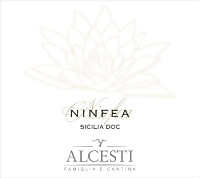
|
|
Sicilia Grillo Chardonnay Ninfea 2017 |
|
| Alcesti (Sicily, Italy) | |
 Grillo (60%), Chardonnay (40%) Grillo (60%), Chardonnay (40%) | |
| Price: € 12.00 | Score: |
 Brilliant golden yellow and nuances of golden yellow, very transparent. Brilliant golden yellow and nuances of golden yellow, very transparent. Intense, clean, pleasing and refined, starts with hints of banana,
peach and acacia followed by aromas of hawthorn, apple, grapefruit, pear,
hazelnut, butter and vanilla. Intense, clean, pleasing and refined, starts with hints of banana,
peach and acacia followed by aromas of hawthorn, apple, grapefruit, pear,
hazelnut, butter and vanilla.
 Crisp attack and however balanced by alcohol, good body, intense
flavors, pleasing roundness. Crisp attack and however balanced by alcohol, good body, intense
flavors, pleasing roundness.
 Persistent finish with flavors of banana, apple and grapefruit. Persistent finish with flavors of banana, apple and grapefruit. 9 months part in steel tanks and part in barrique, 3 months in bottle. 9 months part in steel tanks and part in barrique, 3 months in bottle. |
|
 Stuffed pasta, Roasted fish, Roasted white meat, Mushroom soups Stuffed pasta, Roasted fish, Roasted white meat, Mushroom soups |
|
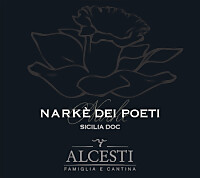
|
|
Sicilia Nero d'Avola Cabernet Sauvignon Narkè dei Poeti 2017 |
|
| Alcesti (Sicily, Italy) | |
 Nero d'Avola (60%), Cabernet Sauvignon (40%) Nero d'Avola (60%), Cabernet Sauvignon (40%) | |
| Price: € 11.00 | Score: |
 Intense ruby red and nuances of garnet red, little transparency. Intense ruby red and nuances of garnet red, little transparency. Intense, clean, pleasing and refined, starts with hints of black
cherry, plum and dried violet followed by aromas of blackberry, blueberry,
black currant, carob, tobacco, cinnamon, clove and vanilla. Intense, clean, pleasing and refined, starts with hints of black
cherry, plum and dried violet followed by aromas of blackberry, blueberry,
black currant, carob, tobacco, cinnamon, clove and vanilla.
 Properly tannic attack and however balanced by alcohol, good body,
intense flavors, agreeable. Properly tannic attack and however balanced by alcohol, good body,
intense flavors, agreeable.
 Persistent finish with flavors of black cherry, plum and blackberry. Persistent finish with flavors of black cherry, plum and blackberry. 12 months in barrique and cask, 6 months in bottle. 12 months in barrique and cask, 6 months in bottle. |
|
 Roasted meat, Broiled meat and barbecue, Stewed meat with mushrooms, Cheese Roasted meat, Broiled meat and barbecue, Stewed meat with mushrooms, Cheese |
|
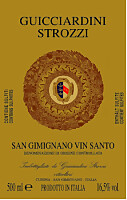
|
|
San Gimignano Vin Santo 2008 |
|
| Guicciardini Strozzi (Tuscany, Italy) | |
 Trebbiano Toscano, Malvasia Bianca, San Colombano Trebbiano Toscano, Malvasia Bianca, San Colombano | |
| Price: € 20.00 - 500ml | Score: |
 Brilliant amber yellow and nuances of amber yellow, transparent. Brilliant amber yellow and nuances of amber yellow, transparent. Intense, clean, pleasing, refined and elegant, starts with hints of
dried fig, dried apricot and quince jam followed by aromas of peach jam,
date, honey, candied fruits, leather, citrus fruit peel, caramel, hazelnut,
vanilla and nail polish. Intense, clean, pleasing, refined and elegant, starts with hints of
dried fig, dried apricot and quince jam followed by aromas of peach jam,
date, honey, candied fruits, leather, citrus fruit peel, caramel, hazelnut,
vanilla and nail polish.
 Sweet and round attack, however balanced by alcohol, good body, intense
flavors, pleasing crispness. Sweet and round attack, however balanced by alcohol, good body, intense
flavors, pleasing crispness.
 Persistent finish with flavors of dried fig, dried apricot and honey. Persistent finish with flavors of dried fig, dried apricot and honey. More than 4 years in "caratelli" barrels. More than 4 years in "caratelli" barrels. |
|
 Confectionery, Dried fruit tarts, Hard cheese Confectionery, Dried fruit tarts, Hard cheese |
|
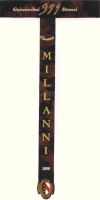
|
|
Millanni 2015 |
|
| Guicciardini Strozzi (Tuscany, Italy) | |
 Sangiovese (60%), Cabernet Sauvignon (30%), Merlot (10%) Sangiovese (60%), Cabernet Sauvignon (30%), Merlot (10%) | |
| Price: € 32.00 | Score: |
 Intense ruby red and nuances of garnet red, little transparency. Intense ruby red and nuances of garnet red, little transparency. Intense, clean, pleasing, refined and elegant, starts with hints of
black cherry, plum and dried violet followed by aromas of blueberry,
blackberry, black currant, carnation, chocolate, tobacco, mace, vanilla and
menthol. Intense, clean, pleasing, refined and elegant, starts with hints of
black cherry, plum and dried violet followed by aromas of blueberry,
blackberry, black currant, carnation, chocolate, tobacco, mace, vanilla and
menthol.
 Properly tannic attack and however balanced by alcohol, good body,
intense flavors, agreeable. Properly tannic attack and however balanced by alcohol, good body,
intense flavors, agreeable.
 Persistent finish with flavors of black cherry, plum and blueberry. Persistent finish with flavors of black cherry, plum and blueberry. 18 months in barrique. 18 months in barrique. |
|
 Roasted meat, Stewed and braised meat with mushrooms, Cheese Roasted meat, Stewed and braised meat with mushrooms, Cheese |
|
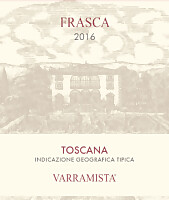
|
|
Frasca 2016 |
|
| Fattoria Varramista (Tuscany, Italy) | |
 Sangiovese (60%), Merlot (20%), Syrah (20%) Sangiovese (60%), Merlot (20%), Syrah (20%) | |
| Price: € 25.00 | Score: |
 Intense ruby red and nuances of ruby red, little transparency. Intense ruby red and nuances of ruby red, little transparency. Intense, clean, pleasing, refined and elegant, starts with hints of
black cherry, blueberry and black currant followed by aromas of violet,
carnation, plum, pomegranate, tobacco, chocolate, leather, thyme, vanilla
and menthol. Intense, clean, pleasing, refined and elegant, starts with hints of
black cherry, blueberry and black currant followed by aromas of violet,
carnation, plum, pomegranate, tobacco, chocolate, leather, thyme, vanilla
and menthol.
 Properly tannic attack and however balanced by alcohol, good body,
intense flavors, agreeable. Properly tannic attack and however balanced by alcohol, good body,
intense flavors, agreeable.
 Persistent finish with flavors of black cherry, blueberry and black
currant. Persistent finish with flavors of black cherry, blueberry and black
currant.
 Sangiovese ages for 24 months in cask, Syrah and Merlot 24 months in
barrique, 6 months in steel tanks, at least 12 months in bottle. Sangiovese ages for 24 months in cask, Syrah and Merlot 24 months in
barrique, 6 months in steel tanks, at least 12 months in bottle.
|
|
 Broiled meat and barbecue, Stewed meat with mushrooms, Roasted meat, Cheese Broiled meat and barbecue, Stewed meat with mushrooms, Roasted meat, Cheese |
|
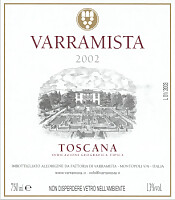
|
|
Varramista 2002 |
|
| Fattoria Varramista (Tuscany, Italy) | |
 Syrah (90%), Merlot (10%) Syrah (90%), Merlot (10%) | |
| Price: € 54.00 | Score: |
 Brilliant garnet red and nuances of brick red, little transparency. Brilliant garnet red and nuances of brick red, little transparency. Intense, clean, pleasing, refined and elegant, starts with hints of
black cherry jam, plum jam and dried violet followed by aromas of blueberry
jam, carob, tobacco, cocoa, leather, tamarind, licorice, tar, vanilla and
eucalyptus. Intense, clean, pleasing, refined and elegant, starts with hints of
black cherry jam, plum jam and dried violet followed by aromas of blueberry
jam, carob, tobacco, cocoa, leather, tamarind, licorice, tar, vanilla and
eucalyptus.
 Properly tannic attack and however balanced by alcohol, good body,
intense flavors, agreeable. Properly tannic attack and however balanced by alcohol, good body,
intense flavors, agreeable.
 Persistent finish with flavors of black cherry jam, plum jam and
blueberry jam. Persistent finish with flavors of black cherry jam, plum jam and
blueberry jam.
 15 months in barrique, 15 months in bottle. 15 months in barrique, 15 months in bottle. |
|
 Roasted meat, Stewed and braised meat with mushrooms, Hard cheese Roasted meat, Stewed and braised meat with mushrooms, Hard cheese |
|
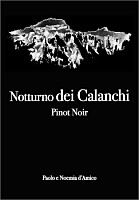
|
|
Notturno dei Calanchi 2016 |
|
| Paolo e Noemia d'Amico (Umbria, Italy) | |
 Pinot Nero Pinot Nero | |
| Price: € 30.00 | Score: |
 Intense ruby red and nuances of garnet red, little transparency. Intense ruby red and nuances of garnet red, little transparency. Intense, clean, pleasing, refined and elegant, starts with hints of
cherry, plum and blueberry followed by aromas of cyclamen, dried rose,
raspberry, cinnamon, tobacco, cocoa, licorice, leather, vanilla and
menthol. Intense, clean, pleasing, refined and elegant, starts with hints of
cherry, plum and blueberry followed by aromas of cyclamen, dried rose,
raspberry, cinnamon, tobacco, cocoa, licorice, leather, vanilla and
menthol.
 Properly tannic attack and however balanced by alcohol, good body,
intense flavors, pleasing crispness. Properly tannic attack and however balanced by alcohol, good body,
intense flavors, pleasing crispness.
 Persistent finish with flavors of cherry, plum and raspberry. Persistent finish with flavors of cherry, plum and raspberry. 10 months in barrique, 10 months in bottle. 10 months in barrique, 10 months in bottle. |
|
 Stuffed pasta with mushrooms, Broiled meat and barbecue, Stewed meat with mushrooms, Cheese Stuffed pasta with mushrooms, Broiled meat and barbecue, Stewed meat with mushrooms, Cheese |
|
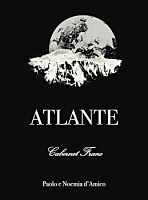
|
|
Atlante 2015 |
|
| Paolo e Noemia d'Amico (Umbria, Italy) | |
 Cabernet Franc Cabernet Franc | |
| Price: € 36.00 | Score: |
 Intense ruby red and nuances of garnet red, little transparency. Intense ruby red and nuances of garnet red, little transparency. Intense, clean, pleasing, refined and elegant, starts with hints of
black cherry, plum and blueberry followed by aromas of dried violet, black
currant, bell pepper, cocoa, leather, tobacco, licorice, cinnamon, mace,
vanilla and eucalyptus. Intense, clean, pleasing, refined and elegant, starts with hints of
black cherry, plum and blueberry followed by aromas of dried violet, black
currant, bell pepper, cocoa, leather, tobacco, licorice, cinnamon, mace,
vanilla and eucalyptus.
 Properly tannic attack and however balanced by alcohol, good body,
intense flavors, agreeable. Properly tannic attack and however balanced by alcohol, good body,
intense flavors, agreeable.
 Persistent finish with flavors of black cherry, plum and blueberry. Persistent finish with flavors of black cherry, plum and blueberry. 15 months in barrique, 15 months in bottle. 15 months in barrique, 15 months in bottle. |
|
 Stewed meat with mushrooms, Broiled meat and barbecue, Roasted meat Stewed meat with mushrooms, Broiled meat and barbecue, Roasted meat |
|
News |
|
In this section are published news and information about events concerning the world of wine and food. Whoever is interested in publishing this kind of information can send us a mail to our address.
|
AquavitaeReview of Grappa, Distillates and Brandy |
|
|
||||||||||||
Wine Guide ParadeSummer 2021
|
| |||||||
Privacy Policy | |||||||


| Copyright © 2002-2024 Antonello Biancalana, DiWineTaste - All rights reserved |
| All rights reserved under international copyright conventions. No part of this publication and of this WEB site may be
reproduced or utilized in any form or by any means, electronic or mechanical, without permission in writing from DiWineTaste. |